Gymnastics
Today, we had an even more exciting PE lesson than normal!
As we’ve been gymnasts, we’ve been practising skills such as balance, movement and control – including when mounting and dismounting apparatus.
In this lesson, we put it all to the test by using the equipment shown below. At times, we had to see how high we could go (which was hard for Miss Wilson on the rope) or how we could travel across the bars from one side to the other.
As always, we were safe and worked fantastically as a team.
It was a lot of fun!




Help at home by discussing the ways we kept safe in today’s lesson.
Sketches, Sculptures & Maquettes
In Art, this week and last week, we have moved away from Art History and turned our attention to our own art projects.


We sketched a maquette which is the first stage in our sculpture process.

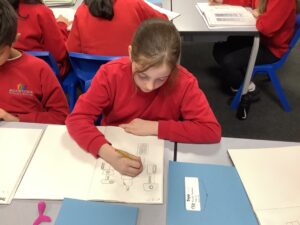
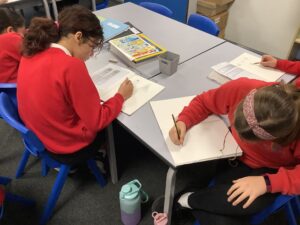
Next, we came together as a group to create a joint maquette which is the final stage of our planning process.



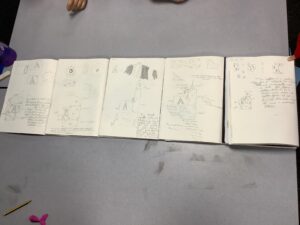


Help at home by discussing the visual and tactile elements of art that they’ve used in their maquette such as line, shape and composition.
Art, art and more art!
After many weeks of learning and discussing the artwork of Kandinsky and Napaltjarri, Year 3 have designed and begun creating sculptures that are inspired by them!
First, they sketched and drew rough designs of the shapes, colours and patterns that they wanted to use.
Then, they began cutting their shapes. As you can see, lots of the children have chosen to have a mix of shapes. Kandinsky is well known for his concentric circles so we have been inspired to use circles too.
The next step was then to start decorating these shapes using oil pastels, chalks and eventually, wax resist! Some have chosen warm colours, complementary or cool colours. Napaltjarri uses a lot of warm colours while Kandinsky uses complementary.
Some of us are ready to start slotting these shapes together to make our sculpture three-dimensional. Come back next week to see our final pieces…
Help at home by identifying colours of everyday objects. What kind of colour is your blue wallpaper? How does that blue make me feel? What does it remind me?
Living and Learning: mental health
For the past three weeks, we have been focussing on mental health in our Living and Learning lessons. This week, we discussed how to identify worry and actions that a person can take if they feel worried.
Year 6 identified how our bodies might feel if they are worried: a strange feeling in someone’s stomach, chest, head or throat; a faster heartbeat; dry mouth; sweaty palms; fidgeting; or difficulty concentrating.
We then focussed on different things that can be done to help relieve the worry:
- taking deep breaths
- talking to friends or family
- reading a book
- mindfulness activities
- playing a sport
- writing it down
Last week, we discussed different self-care techniques surrounding grief, which is the name given to the feeling of pain when experiencing a loss. There can be lots of different types: a family member moving away, a breakdown in friendship, or loved one dying.
Similar to how worry can affect us, grief can impact us in a wide variety of ways.
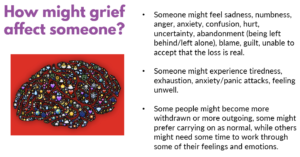
We decided that one of the best self-care techniques was to talk to someone and explain what’s happening.
Help at home by discussing what else would be useful, immediately after and a longer time after experiencing a loss.
Guided Reading Week 5
Here are the target pages for this week’s guided reading. These need to be read by Friday 15th December.
Extra Time: end of book.
Flood and Fang: up to chapter 15/page 183.
Dirty Bertie: up to page 187.
Kensuke’s Kingdom: end of book.
If your child is in ‘The Boy and the Tiger’ group, they will have finished their guided reading book for this half term so can complete their reading record activity on a book of their choice.
Art – printing designs
In Year 2, we have been exploring line, pattern and shape in our Arty Ideas books. Some of the inspiration has come from our visit to The Hepworth Wakefield and from looking at the work of Paul Klee.
We choose our favourite design to draw and mark on to printing tiles.





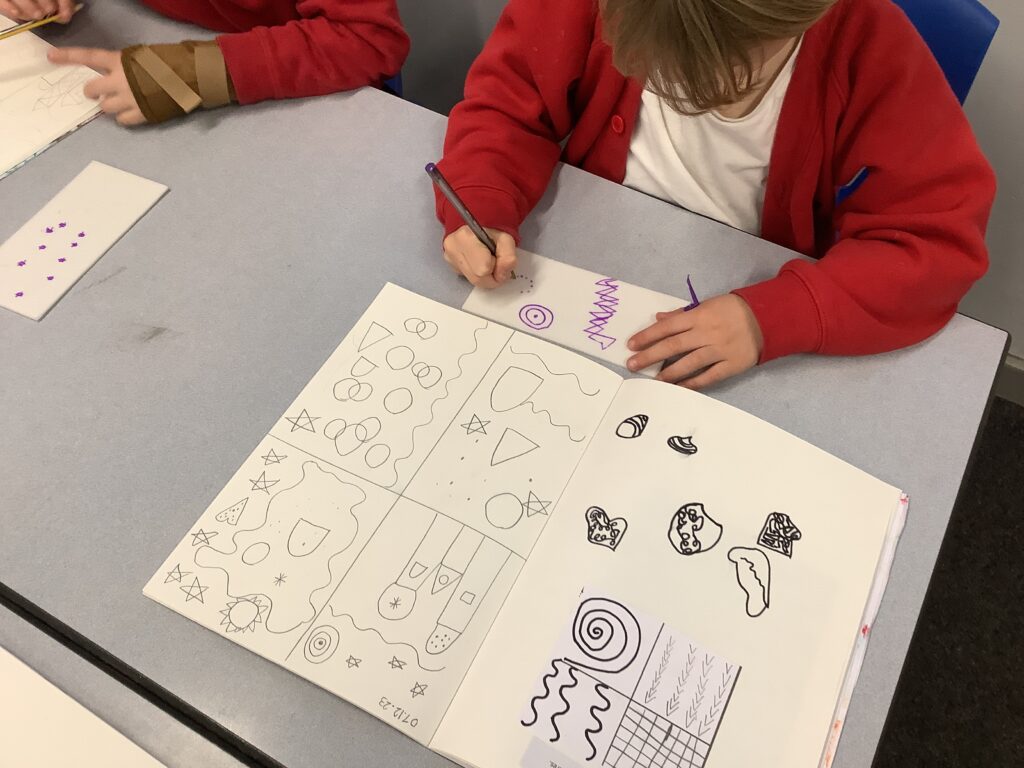
Autumn 2: Week 5
Phonics
This week, we recapped all of the phase 2 phonemes. We also practiced reading words with ‘s’ at the end.
Help at home: Can your child read the following words?
ships, bags, cats, pots, cups, pins, digs
We’ve learnt all of the phase 2 tricky words. Tricky words can be challenging because we can’t sound them out – we just have to know them by sight.

Help at home: Have fun finding tricky words around your house.
How to play:
- Write the phase 2 tricky words on pieces on paper.
- Stick them up around your house.
- How many can you find? Don’t forget to read them!
- You could race someone at home.
Poetry Picnic
Each week, we learn a new poem. We recite the poem each day. Click here to watch this week’s poem.

Owl babies
This week, we’ve been reading Owl Babies by Martin Waddell.
 We drew a picture of our favourite part and retold the story using words and actions.
We drew a picture of our favourite part and retold the story using words and actions.
 Click on the links below to watch some of us.
Click on the links below to watch some of us.
Video 1
Video 2
Video 3
Stamps!
Next week, we’ll be learning all about what happens to our post when reading the story ‘The Jolly Christmas Postman’. To enhance your child’s learning experience, we will be writing and then posting a postcard home.
If you would like your child’s postcard to be posted through the Royal Mail please provide a stamp in a named envelope by Thursday 14 December.
It’s beginning to look a lot like Christmas…
This morning, we got to decorate the school Christmas tree in the hall. We had so much fun!
 Reminder!
Reminder!
Don’t forget to attend a learning journey drop in next week! We look forward to sharing your child’s books.
Have a happy and healthy weekend.
Maths – 2-D shapes
This week in Maths we learnt all about 2-D shapes. We learnt the names and properties of simple 2-D shapes and different ways we can sort them. Mr McGriffiths tried to trick by turning the shapes around and making them bigger and smaller but we were not fooled. We know that if a shape has 3 sides and 3 corners then it must be a triangle!




We also drew round the shapes to make different pictures on paper. This shape work carried on in our art this week where we used tissue paper shapes to create a background for our prints. We are very excited to see how they will turn out!

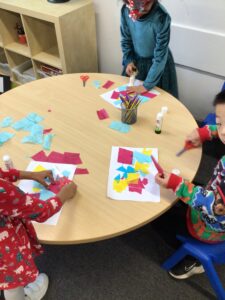
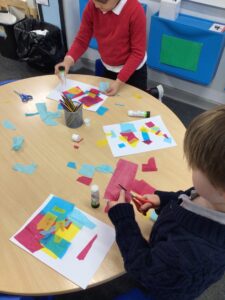
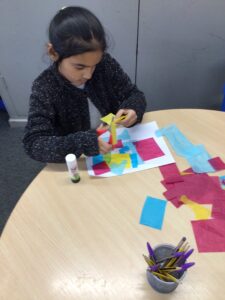
Help at home by spotting 2-D shapes at home.
Living and Learning: What is a feeling?
This week during Living and Learning, we talked about feelings.
What are feelings?
‘A feeling is our emotional state, or our reaction to something. Feelings are important because they help us to manage different situations and look after ourselves. Feelings and emotions are about our minds but we might
also experience them in our bodies.’
What feelings might we have?
We drew ourselves and thought about the different feelings that we might have during the day. For example, feeling sleepy in the morning, overjoyed at break time and determined during a test! Our feelings change throughout the day depending on our experiences.
How can we manage our feelings?
We decided what some good and not so good feelings might be and how we can manage these. Sometimes bad things happen and we need to have some self-care techniques to look after ourselves. Here’s some things that we thought would make ourselves feel good:
- talk to someone
- read a book
- have some quiet time
- get into bed
- take some deep breaths
- hug our teddies
- do some colouring
- go cycling
Feelings are normal and part of life but as long as we have these strategies in place, we will feel much better overall! Help at home by encouraging your child to practise some of these techniques when they are not feeling so good. Take some deep breaths, get some fresh or talk to someone!
Write it like a poet!
Today, Year 3 had a visitor from the British Library. We learnt a lot about the British Library like what they do, how they are different to a “normal” library and where they are based. Luckily for us, they have a base in Boston Spa!
The British Library have a copy of every single book, newspaper, magazine or even leaflet that has been published in Britain. They want to keep a record of all of these so that in years to come, people can look back and see what things were like over the years!
We read a few poems, picked a part the vocabulary and discussed what we liked and disliked about them. Then it was our turn to write our own poems. It can be quite tricky just to sit down and write a poem so we played lots of games to help us generate some ideas.
Some of us wrote about our day, our emotions, a hobbie we like or just something random! The children really enjoyed it and were desperate to share their writing at the end.

Help at home by playing the word association game. Start with ‘apple’ and see what word the other person can think of that links to it!





